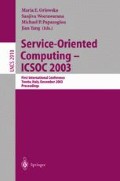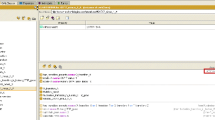Abstract
Web portals provide an efficient gateway to a broad range of E-services, resources and information. Web portals need to evolve towards being adaptive in nature, so that the ensuing E-services provided by them are dynamically tailored to meet the diverse needs of its users. This paper explores the use of intelligent techniques, in particular constraint satisfaction methods, to develop adaptive E-services that provide customized and factually consistent information to users. We model the generation of customized information content as a constraint satisfaction problem—a solution is derived by (a) satisfying user-model constraints with information document selection constraints; and (b) establishing inter-document consistency when dynamically combining heterogeneous information documents. The work is applied in an E-Healthcare setting leading to the generation of personalized healthcare information.
Chapter PDF
Similar content being viewed by others
Keywords
- User Profile
- Constraint Satisfaction
- Constraint Satisfaction Problem
- Information Coverage
- Information Package
These keywords were added by machine and not by the authors. This process is experimental and the keywords may be updated as the learning algorithm improves.
References
Rust, R.T., Lemon, K.N.: E-service and the consumer. International Journal of Electronic Commerce 5(3), 85–102 (2001)
Helal, S., Su, S., Meng, J., Krithivasan, R., Jagatheesan, A.: The Internet enterprise. In: Proceedings of Symposium on Application and the Internet (2002)
Zirpins, C., Weinreich, H., Bartelt, A., Lamersdorf, W.: Advanced concepts for next generation portals. In: Proceedings of 12th International Workshop on Database and Expert Systems Applications, September 3-7, pp. 501–506 (2001)
Piccinelli, G., Salle, M., Zirpins, C.: Service-oriented modelling for e-business applications components. In: Proceedings of 10th IEEE International Workshops on Enabling Technologies: Infrastructure for Collaborative Enterprises (WET ICE), June 20-22, pp. 12–17 (2001)
Bogonikolos, N., Makris, C., Tsakalidis, A., Vassiliadis, B.: Adapting information presentation and retrieval through user modeling. In: Proceedings of International Conference on Information Technology: Coding and Computing, April 2-4, pp. 399–104 (2001)
Zhang, Y., Im, I.: Recommender systems: A framework and research issues. In: Proceedings of American Conference on Information Systems (2002)
Fink, J., Kobsa, A.: Putting personalization into practice. Communications of the ACM 45(5) (2002)
Abidi, S.S.R., Chong, Y., Abidi, S.R.: Patient empowerment via ‘pushed’ delivery of personalized healthcare Educational content over the internet. In: Proceedings of 10th World Congress on Medical Informatics, London (2001)
Brusilovsky, P.: Methods and techniques of adaptive hypermedia. In: Brusilovsky, P., Kobsa, A., Vassileva, J. (eds.) Adaptive Hypertext and Hypermedia, pp. 1–43. Kluwer Academic Publishers, Dordrecht (1998a)
Brusilovsky, P., Kobsa, A., Vassileva, J. (eds.): Adaptive Hypertext and Hypermedia. Kluwer Academic Publishers, Dordrecht (1998b)
Kobsa, A.: Personalized hypermedia presentation techniques for improving online customer relationships. The Knowledge Engineering Review 16(2), 111–155 (1999)
Perkowitz, M., Etzioni, O.: Adaptive web sites. Communications of the ACM 43(8), 152–158 (2000)
Henze, N., Nejdl, W.: Extendible adaptive hypermedia courseware: integrating different courses and web material. In: Brusilovsky, P., Stock, O., Strapparava, C. (eds.) AH 2000. LNCS, vol. 1892, pp. 109–120. Springer, Heidelberg (2000)
Kobsa, A., Muller, D., Nill, A.: KN-AHS: an adaptive hypermedia client of the user modeling system BGP-MS. In: Proceeding of the Fourth International Conference on User Modeling, pp. 99–105 (1994)
Boyle, C., Encarnacion, A.O.: MetaDoc: An adaptive hypertext reading system. User Models and User Adapted Interaction 4(1), 1–19 (1994)
Ardissono, L., Goy, A.: Tailoring the interaction with users in web stores. User Modelling and User Adapted Interaction 10(4), 251–303 (2000)
Hohl, H., Bocker, H.D., Gunzenhauser, R.: HYPADAPTER: an adaptive hypertext system for exploratory learning and programming. User Modelling and User Adapted Interaction 6(2), 131–155
Kaplan, C., Fenwick, J., Chen, J.: Adaptive hypertext navigation based on user goals and context. User Modelling and User Adapted Interaction 3(3), 193–220
Oppermann, R., Specht, M.: A context sensitive nomadic information system as an exhibition guide. In: Thomas, P., Gellersen, H.-W. (eds.) HUC 2000. LNCS, vol. 1927, pp. 127–142. Springer, Heidelberg (2000)
Tsang, E.: Foundations of constraint satisfaction. Academic Press, London (1993)
Sabin, D., Freuder, E.: Configuration as composite constraint satisfaction. In: Proceedings of the Artificial Intelligence and Manufacturing Research Planning Workshop, pp. 153–161 (1996)
Torrens, M., Faltings, B.: SmartClients: Constraint satisfaction as a paradigm for scale-able intelligent information systems. In: Workshop on Artificial Intelligence on Electronic Commerce, AAAI 1999, Orlando, Florida, USA (1999)
De Rosis, F., Pizzutilo, S., Russo, A.: User tailored hypermedia explanations. In: INTERCHI 1993 Adjunct proceedings, Amsterdam (1993)
Beaumont, I.H.: User modeling in the interactive anatomy tutoring system ANATOMTUTOR. User Models and User Adapted Interaction 4(1), 21–45 (1994)
Barták, R.: Constraint programming: In pursuit of the holy grail. In: Proceedings of the Week of Doctoral Students (WDS 1999), Part IV, pp. 555–564. MatFyzPress, Prague (1999)
Brohman, M.T., Watson, R.T., Piccoli, G., Parasuraman, A.: Data completeness: A key to effective net-based customer service systems. Communications of the ACM 46(6), 47–51 (2003)
Bental, D.: Adapting web-based information to the needs of patients with cancer. In: Proceedings of International Conference On Adaptive Hypertext and Adaptive Web-based Systems, Trento, Italy, pp. 27–37 (2000)
Wilke, W., Bergmann, R.: Techniques and Knowledge Used for Adaptation During Case Based Problem Solving. In: Mira, J., Moonis, A., de Pobil, A.P. (eds.) IEA/AIE 1998. LNCS (LNAI), vol. 1416, Springer, Heidelberg (1998)
Author information
Authors and Affiliations
Editor information
Editors and Affiliations
Rights and permissions
Copyright information
© 2003 Springer-Verlag Berlin Heidelberg
About this paper
Cite this paper
Abidi, S.S.R., Chong, Y.H. (2003). E-healthcare via Customized Information Services: Addressing the Need for Factually Consistent Information. In: Orlowska, M.E., Weerawarana, S., Papazoglou, M.P., Yang, J. (eds) Service-Oriented Computing - ICSOC 2003. ICSOC 2003. Lecture Notes in Computer Science, vol 2910. Springer, Berlin, Heidelberg. https://doi.org/10.1007/978-3-540-24593-3_10
Download citation
DOI: https://doi.org/10.1007/978-3-540-24593-3_10
Publisher Name: Springer, Berlin, Heidelberg
Print ISBN: 978-3-540-20681-1
Online ISBN: 978-3-540-24593-3
eBook Packages: Springer Book Archive




